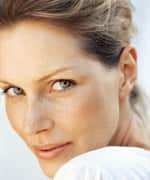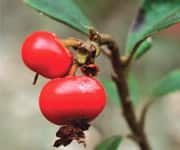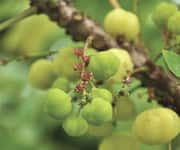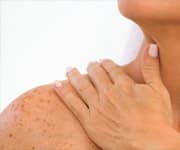Life Extension Magazine®

Combating fine lines and wrinkles usually tops the list when it comes to retaining a youthful appearance, but ignoring an uneven skin tone and unwanted pigmentation can add years to your perceived age.
Over time, your picture-perfect complexion begins to display hyperpigmentation in the form of undesirable dark patches, unsightly brown and black growths, and mottling in the skin. An interesting research finding demonstrated that hyperpigmentation can make you look up to 20 years older!1
Hyperpigmentation stems from enhanced production2 and uneven distribution of melanin,3 the skin’s predominant pigment. While hydroquinone remains the gold standard for treating this common condition,4 it has fallen out of favor due to published studies reporting its allergenic5,6 and carcinogenic properties.7,8 This has sparked interest in agents that have comparable skin-lightening effects to hydroquinone without the serious side effects.
In this article, you’ll learn how three natural compounds work through multiple mechanisms to normalize melanin output and promote its even distribution in the epidermis for the appearance of even-toned, younger-looking skin.
Targeting Melanogenesis
As we age, melanin-synthesizing cells known as melanocytes become victim to excess sun exposure, inflammation, free radicals, and hormonal changes.9,10 This triggers melanocytes to overproduce melanin, resulting in its uneven distribution in the epidermis. The outward appearance of hyperpigmentation and dark spots soon follows, with some of the most common sites being the face, arms, back, and hands.1,11
The process of melanin synthesis (melanogenesis) can be narrowed down to the following three steps, regardless of the initiating factors involved: An early rate-limiting step involves the transformation of L-tyrosine to L-DOPA through tyrosinase or tyrosine hydroxylase. Then a series of intramolecular transformations occur, continuing the process of melanogenesis. Finally, mature melanosomes are transferred to more superficial keratinocytes. There, melanin provides skin color and frontline protection against the damaging effects of UV rays.9,12 As we age, this process becomes dysregulated, causing the skin’s outward appearance to develop unsightly dark spots and uneven areas of hyperpigmentation.
After rigorous research and testing, scientists have zeroed in on three ingredients that intervene in melanogenesis to favorably modulate skin pigmentation.
Alpha-Arbutin

Since the key enzyme tyrosinase is a regulator of melanogenesis, it is a prominent target to control melanin formation and improve age-related skin discoloration. Scientists have discovered that alpha-arbutin, a compound derived from the leaves of the bearberry plant, exhibits a strong inhibitory effect on tyrosinase. This helps explain why a human skin model treated with alpha-arbutin decreased melanin synthesis by 60% compared to a control.13
The ability of alpha-arbutin to dramatically decrease melanin production has translated into impressive findings in humans, with studies showing it has significantly faster skin-lightening effects than other commonly used agents. In one study of 80 participants, scientists compared the efficacy of alpha-arbutin against hydroquinone and kojic acid for decreasing hyperpigmentation. They found that topical application of alpha-arbutin increased skin lightness 60% over hydroquinone, and 25% over kojic acid. Both these results were observed after just one month!14,15
Liver spots (age spots) are the visible consequences of chronic sun exposure. A three-month study revealed that more than 80% of participants who topically applied a formulation of alpha-arbutin showed noticeable reductions in the appearance of liver spots.14,15
Phyllanthus Emblica Extract

Phyllanthus emblica, also known as Indian gooseberry,has a long history in Ayurvedic medicine for treating a variety of health ailments, from gastrointestinal disorders to liver diseases.16 The latest research indicates that it can now add effective skin lightener to its already impressive resume.
In the laboratory, a standardized extract of Phyllanthus emblica displayed potent free-radical scavenging activity.17 Oxidative stress may be an early step in the activation of tyrosinase.18-21 It also binds to copper, which is required for tyrosinase function.17
In human studies, extracts of Phyllanthus emblica were superior to both vitamin E and the conventional skin lightener magnesium ascorbyl phosphate (MAP) in preventing and reversing UV-induced pigmentation.17 One study showed that human volunteers applying a topical preparation of Phyllanthus emblica twice daily for nine weeks had markedly lighter skin at the study’s end compared to those applying MAP.17
Another study compared Phyllanthus emblica extract to hydroquinone for reducing upper arm hyperpigmentation. Subjects applied a topical application of either Phyllanthus emblica or hydroquinone twice daily to the designated area for six weeks. Researchers used the parameter individual typology angle (ITAº) to evaluate the intensity of skin pigmentation, with a higher ITAº signifying lighter skin. They found that treatment with Phyllanthus emblica extract significantly increased ITAº and was as effective as hydroquinone. This research demonstrates that Phyllanthus emblica provides similar skin-lightening properties to hydroquinone without the adverse effects.17
When investigators examined the impact of Phyllanthus emblica extract on freckles in 19 patients, they observed that 89.5% of participants experienced significant fading of freckles in the facial area after just eight weeks.17
What You Need To Know
 |
Melanin, Age-Related Skin Discoloration, And Pigment-Fading Compounds
- Melanin is the skin’s color-providing pigment that offers protection against damaging UV rays.
- As we age, melanin-producing melanocytes become victim to chronic sun exposure, inflammation, free radicals, and hormonal changes.
- These factors increase activation of a key enzyme called tyrosinase. This leads to the overproduction of melanin, which causes its uneven distribution in the epidermis.
- The outward appearance of hyperpigmentation soon follows, typically as age spots, freckles, and melasma.
- As safety concerns mount for the traditional therapy hydroquinone, scientists have zeroed in on three safer alternatives.
- Alpha-arbutin increased skin lightness 60% over hydroquinone and 25% over kojic acid in human volunteers in one month.
- Phyllanthus emblica extract deactivates tyrosinase to enhance skin lightness and reduce the appearance of freckles.
- Niacinamide blocks melanin transfer to the outer layers of the skin, which has been shown to decrease facial hyperpigmentation and improve melasma.
Niacinamide
While alpha-arbutin and Phyllanthus emblica extract inhibit melanin synthesis to lighten discolored areas of the skin, a derivative of niacin (vitamin B3) known as niacinamide operates through an entirely different mechanism to provide the same benefit.
Scientists found that niacinamide suppressed the transfer of melanin to nearby keratinocytes on the surface of the skin by up to 68%.22 In other words, niacinamide blocked the accumulation of melanin in the epidermis that contributes to skin darkening.
In a double-blind clinical trial of 18 women aged 25-60, topical niacinamide was applied twice daily to one side of the face and placebo to the other for eight weeks. Compared to baseline, the treatment group reduced total area of hyperpigmentation by 25% versus only 15% in the placebo group. More subjects in the niacinamide group reported lighter skin than in the placebo group.22
One of the most common and hard-to-treat skin disorders is melasma, a condition characterized by facial hyperpigmentation.23 Although it affects both sexes, melasma occurs more frequently in women.24 Eight weeks of topical niacinamide was shown to be nearly as effective as hydroquinone for treating melasma. Even better, niacinamide produced fewer side effects than its counterpart. This led the researchers to conclude that niacinamide was “an effective, integral, and safe therapeutic alternative in the melasma treatment.”24
Summary
Marked changes in the skin’s primary pigment melanin results in undesirable hyperpigmentation that can add years to your perceived age. Fortunately, a topical cream has been formulated with three natural compounds that show comparable skin lightening effects to hydroquinone without the serious side effects. Three ingredients, alpha-arbutin, Phyllanthus emblica extract, and niacinamide, beneficially modulate melanin synthesis and transfer to reduce the visual appearance of age spots, freckles, and melasma. This translates into more even-toned, radiant, younger-looking skin.
If you have any questions on the scientific content of this article, please call a Life Extension® Health Advisor at 1-866-864-3027.
References
- Matts PJ, Fink B, Grammer K, Burquest M. Color homogeneity and visual perception of age, health, and attractiveness of female facial skin. J Am Acad Dermatol. 2007 Dec;57(6):977-84.
- Available at: http://www.ncbi.nlm.nih.gov/pubmedhealth/pmh0003708. Accessed April 22, 2014.
- Franco DC, de Carvalho GS, Rocha PR, da Silva Teixeira R, da Silva AD, Raposo NR. Inhibitory effects of resveratrol analogs on mushroom tyrosinase activity. Molecules. 2012 Oct 9;17(10):11816-25.
- Makino ET, Mehta RC, Banga A, Jain P, Sigler ML, Sonti S. Evaluation of a hydroquinone-free skin brightening product using in vitro inhibition of melanogenesis and clinical reduction of ultraviolet-induced hyperpigmentation. J Drugs Dermatol. 2013 Mar;12(3):s16-20.
- Available at: http://toxnet.nlm.nih.gov/cgi-bin/sis/search/r?dbs+hsdb:@term+@rn+@rel+123-31-9. Accessed April 22, 2014.
- Hulette BC, Ryan CA, Gildea LA, Gerberick GF. Relationship of CD86 surface marker expression and cytotoxicity on dendritic cells exposed to chemical allergen. Toxicol Appl Pharmacol. 2005 Dec 1;209(2):159-66.
- McGregor D. Hydroquinone: an evaluation of the human risks from its carcinogenic mutagenic properties. Crit Rev Toxicol. 2007;37(10):887-914.
- Enguita FJ, Leitão AL. Hydroquinone: environmental pollution, toxicity, and microbial answers. Biomed Res Int. 2013;2013:542168.
- Slominski A, Tobin DJ, Shibahara S, Wortsman J. Melanin pigmentation in mammalian skin and its hormonal regulation. Physiol Rev. 2004 Oct;84(4):1155-228.
- Costin GE, Hearing VJ. Human skin pigmentation: melanocytes modulate skin color in response to stress. FASEB J. 2007 Apr;21(4):976-94.
- Plensdorf S, Martinez J. Common pigmentation disorders. Am Fam Physician. 2009 Jan 15;79(2):109-16.
- Brenner M, Hearing VJ. The protective role of melanin against UV damage in human skin. Photochem Photobiol. 2008 May-Jun;84(3):539-49.
- Sugimoto K, Nishimura T, Nomura K, et al. Inhibitory effects of alpha-arbutin on melanin sythnesis in cultured human melanoma cells and a three-dimensional human skin model. Biol Pharma Bull. 2004 Apr;27(4):510-4.
- Product monograph: Alpha-Arbutin. Pentapharm. August 2002.
- Available at: http://www.gloprofessional.com/info/uploads/main/ALPHA-ARBUTIN,pdf.pdf. Accessed April 25, 2014.
- Krishnaveni M, Mirunalini S. Therapeutic potential of Phyllanthus emblica (amla):the ayurvedic wonder. J Basic Clin Physiol Pharmacol. 2010;21(1):93-105.
- Product monograph: Emblica™ Rona. December 2002.
- Dizdaroglu M, Jaruga P, Birincioglu M, Rodriguez H. Free radical-induced damage to DNA: mechanisms and measurement.Free Radic Biol Med. 2002 Jun 1;32(11):1102-15.
- Hussain SP, Hofseth LJ, Harris CC. Radical causes of cancer. Nat Rev Cancer . 2003 Apr;3(4):276-85.
- Svobodová A, Vostálová J. Solar radiation induced skin damage: review of protective and preventive options. Int J Radiat Biol . 2010 Dec;86(12):999-1030.
- Park HY, Kosmadaki M, Yaar M, Gilchrest BA. Cellular mechanisms regulating human melanogenesis. Cellular and Molecular Life Sciences. 2009;6:1493–1506.
- Hakozaki T, Minwalla L, Zhuang J, et al. The effect of niacinamide on reducing cutaneous pigmentation and suppression of melanosome transfer. Br J Dermatol. 2002;147:20-31.
- Available at: http://www.the-dermatologist.com/content/treating-difficult-melasma-cases. Accessed April 25, 2014.
- Navarrete-Solis J, Castanedo-Cazares JP, Torres-Alvarez B, et al. A double-blind, randomized clinical trial of niacinamide 4% versus hydroquinone 4% in the treatment of melasma. Dermatol Res Pract. 2011;2011:379173.

